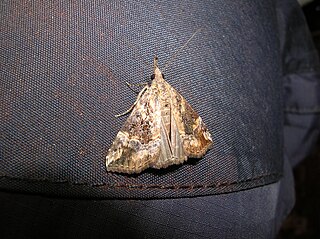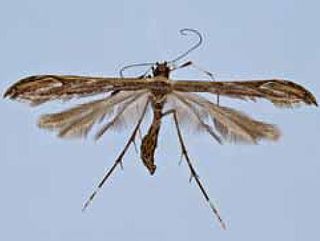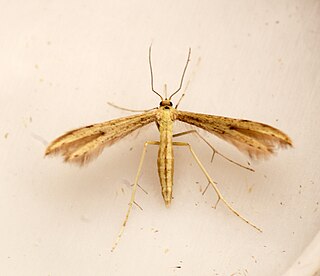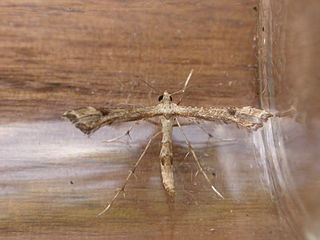
Lantana is a genus of about 150 species of perennial flowering plants in the verbena family, Verbenaceae. They are native to tropical regions of the Americas and Africa but exist as an introduced species in numerous areas, especially in the Australian-Pacific region, South and Northeastern part of India and Bangladesh. The genus includes both herbaceous plants and shrubs growing to 0.5–2 m (1.6–6.6 ft) tall. Their common names are shrub verbenas or lantanas. The generic name originated in Late Latin, where it refers to the unrelated Viburnum lantana.

The Pterophoridae or plume moths are a family of Lepidoptera with unusually modified wings, giving them the shape of a narrow winged airplane. Though they belong to the Apoditrysia like the larger moths and the butterflies, unlike these they are tiny and were formerly included among the assemblage called "microlepidoptera".

Sphenarches anisodactylus, commonly known as the geranium plume moth, is a species of moth in the family Pterophoridae. It is found in western Africa, Madagascar, India, Sri Lanka, Thailand, Japan, the New Hebrides and Central and South America, as well as Australia, where it has been recorded from Cape York to central New South Wales. It is found in the United States, where it has been recorded from Florida, as well as Mississippi. It is also present in the Kermadec Islands of New Zealand.

Exelastis pumilio is a moth of the family Pterophoridae. It has worldwide tropical distribution, including Argentina, Brazil, Colombia, Costa Rica, Cuba, Ecuador, Guadeloupe, Jamaica, Mexico, Puerto Rico, Suriname, Japan, Micronesia, South Africa the Virgin Islands as well as Queensland and New Guinea.

Strymon bazochii, the lantana scrub-hairstreak or smaller lantana butterfly, is a butterfly in the family Lycaenidae. It is found from Paraguay north through Central America, the West Indies and Mexico to southern Texas. It was introduced to Hawaii in 1902 to control Lantana species, in which it has proven unsuccessful.

Hypena laceratalis, the lantana defoliator, is a moth of the family Erebidae. It was first described by Francis Walker in 1859. It is native to Africa to Yemen, India and Myanmar but was deliberately introduced to Australia via Hawaii in 1965 to control the weed Lantana camara.

Hellinsia beneficus is a moth of the family Pterophoridae. It is native to Mexico, but was introduced to Hawaii in 1973 as a biological control agent against mistflower, Ageratina riparia.
Lioptilodes albistriolatus is a moth of the family Pterophoridae. In South America and Central America it has been recorded from Argentina, Brazil, Chile, Costa Rica, Cuba, Ecuador, Guatemala, Paraguay, Peru and Puerto Rico. It is also present in North America, where it is known from Mexico, California, Texas, New Mexico and Arizona. It is an introduced species in Hawaii.

Anstenoptilia marmarodactyla is a moth of the family Pterophoridae. It is native to California and Arizona, south through Mexico to Costa Rica. It is an introduced species in Hawaii.

Crocidosema lantana, the lantana flower-cluster moth or lantana tortricid moth, is a moth of the family Tortricidae. It was first described by August Busck in 1910. It is native to Mexico and the southern United States, but was introduced to Hawaii in 1902, Australia in 1914 and the Caroline Islands in 1948 and 1949 to aid in the control of Lantana weeds. It has also been recorded from Yunnan, China and in Sri Lanka.

Herpetogramma licarsisalis, commonly known as the grass webworm or pale sod-webworm, is a species of moth in the family Crambidae.

Platyptilia farfarellus is a moth of the family Pterophoridae. The species was described by Philipp Christoph Zeller in 1867. It is found from central and southern Europe to Asia Minor, Micronesia and Japan. It is also known from Africa, where it has been recorded from Equatorial Guinea, Kenya, Madagascar, Mauritius, Nigeria, South Africa, São Tomé & Principe, Tanzania, Uganda, the Seychelles and Malawi.

Adaina microdactyla is a moth of the family Pterophoridae first described by Jacob Hübner in 1813. Also known as the hemp-agrimony plume, it is found in Africa, Asia and Europe.
Platyptilia molopias is a moth of the family Pterophoridae. It has a very wide distribution in the Old World tropics, ranging from Africa through India and Sri Lanka, east to Indonesia. It is also found in the Philippines on Luzon, Mindoro, Negros and Mindanao.

Lantanophaga is a genus of moths in the family Pterophoridae. This genus was first described by Elwood Zimmerman in 1958.
Agdistis malitiosa is a moth in the family Pterophoridae. It is known to be from Namibia, South Africa, Kenya, Tanzania, Uganda and the Democratic Republic of Congo.
Bipunctiphorus dimorpha is a moth of the family Pterophoridae. The species was first described by Thomas Bainbrigge Fletcher in 1910. It is known from the Seychelles, Sierra Leone, South Africa, Kenya, Réunion, Madagascar and Tanzania. It has also been recorded from China.
Megalorhipida tessmanni is a moth of the family Pterophoridae that is known from Cameroon, Comoros, Congo, Equatorial Guinea, Ghana, Guinea, Ivory Coast, Madagascar, Malawi, Mauritius, Réunion, South Africa, Tanzania, Uganda, Yemen and Zimbabwe.
Hellinsia madecasseus is a moth of the family Pterophoridae.

Galtara extensa is a moth of the subfamily Arctiinae first described by Arthur Gardiner Butler in 1880. It is found on the Comoros and in Madagascar.














